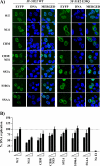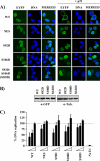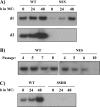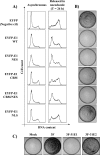Nuclear export of human papillomavirus type 31 E1 is regulated by Cdk2 phosphorylation and required for viral genome maintenance
- PMID: 20844047
- PMCID: PMC2977856
- DOI: 10.1128/JVI.01445-10
Nuclear export of human papillomavirus type 31 E1 is regulated by Cdk2 phosphorylation and required for viral genome maintenance
Abstract
The initiator protein E1 from human papillomavirus (HPV) is a helicase essential for replication of the viral genome. E1 contains three functional domains: a C-terminal enzymatic domain that has ATPase/helicase activity, a central DNA-binding domain that recognizes specific sequences in the origin of replication, and a N-terminal region necessary for viral DNA replication in vivo but dispensable in vitro. This N-terminal portion of E1 contains a conserved nuclear export signal (NES) whose function in the viral life cycle remains unclear. In this study, we provide evidence that nuclear export of HPV31 E1 is inhibited by cyclin E/A-Cdk2 phosphorylation of two serines residues, S92 and S106, located near and within the E1 NES, respectively. Using E1 mutant proteins that are confined to the nucleus, we determined that nuclear export of E1 is not essential for transient viral DNA replication but is important for the long-term maintenance of the HPV episome in undifferentiated keratinocytes. The findings that E1 nuclear export is not required for viral DNA replication but needed for genome maintenance over multiple cell divisions raised the possibility that continuous nuclear accumulation of E1 is detrimental to cellular growth. In support of this possibility, we observed that nuclear accumulation of E1 dramatically reduces cellular proliferation by delaying cell cycle progression in S phase. On the basis of these results, we propose that nuclear export of E1 is required, at least in part, to limit accumulation of this viral helicase in the nucleus in order to prevent its detrimental effect on cellular proliferation.
Figures










Similar articles
-
Mitogen-activated protein kinases activate the nuclear localization sequence of human papillomavirus type 11 E1 DNA helicase to promote efficient nuclear import.J Virol. 2007 May;81(10):5066-78. doi: 10.1128/JVI.02480-06. Epub 2007 Mar 7. J Virol. 2007. PMID: 17344281 Free PMC article.
-
Cyclin/CDK regulates the nucleocytoplasmic localization of the human papillomavirus E1 DNA helicase.J Virol. 2004 Dec;78(24):13954-65. doi: 10.1128/JVI.78.24.13954-13965.2004. J Virol. 2004. PMID: 15564503 Free PMC article.
-
Nuclear accumulation of the papillomavirus E1 helicase blocks S-phase progression and triggers an ATM-dependent DNA damage response.J Virol. 2011 Sep;85(17):8996-9012. doi: 10.1128/JVI.00542-11. Epub 2011 Jul 6. J Virol. 2011. PMID: 21734051 Free PMC article.
-
Dangerous Liaisons: Long-Term Replication with an Extrachromosomal HPV Genome.Viruses. 2021 Sep 16;13(9):1846. doi: 10.3390/v13091846. Viruses. 2021. PMID: 34578427 Free PMC article. Review.
-
The E1 proteins.Virology. 2013 Oct;445(1-2):35-56. doi: 10.1016/j.virol.2013.07.020. Epub 2013 Sep 10. Virology. 2013. PMID: 24029589 Free PMC article. Review.
Cited by
-
The Role of the DNA Damage Response throughout the Papillomavirus Life Cycle.Viruses. 2015 May 21;7(5):2450-69. doi: 10.3390/v7052450. Viruses. 2015. PMID: 26008695 Free PMC article. Review.
-
Viral Subversion of the Chromosome Region Maintenance 1 Export Pathway and Its Consequences for the Cell Host.Viruses. 2023 Nov 6;15(11):2218. doi: 10.3390/v15112218. Viruses. 2023. PMID: 38005895 Free PMC article. Review.
-
Uncovering the Role of the E1 Protein in Different Stages of Human Papillomavirus 18 Genome Replication.J Virol. 2020 Sep 29;94(20):e00674-20. doi: 10.1128/JVI.00674-20. Print 2020 Sep 29. J Virol. 2020. PMID: 32759324 Free PMC article.
-
Cottontail Rabbit Papillomavirus E1 and E2 Proteins Mutually Influence Their Subcellular Localizations.J Virol. 2018 Oct 12;92(21):e00704-18. doi: 10.1128/JVI.00704-18. Print 2018 Nov 1. J Virol. 2018. PMID: 30135125 Free PMC article.
-
DNA damage response is hijacked by human papillomaviruses to complete their life cycle.J Zhejiang Univ Sci B. 2017 Mar;18(3):215-232. doi: 10.1631/jzus.B1600306. J Zhejiang Univ Sci B. 2017. PMID: 28271657 Free PMC article. Review.
References
-
- Amin, A. A., S. Titolo, A. Pelletier, D. Fink, M. G. Cordingley, and J. Archambault. 2000. Identification of domains of the HPV11 E1 protein required for DNA replication in vitro. Virology 272:137-150. - PubMed
-
- Androphy, E. J., D. R. Lowy, and J. T. Schiller. 1987. Bovine papillomavirus E2 transactivating gene product binds to specific sites in papillomavirus DNA. Nature 325:70-73. - PubMed
-
- Chow, L. T., and R. Broker. 1997. Small DNA tumor viruses, p. 267-301. In N. Nathanson (ed.), Viral pathogenesis. Lippincott-Raven, Philadelphia, PA.
Publication types
MeSH terms
Substances
Grants and funding
LinkOut - more resources
Full Text Sources
Medical

